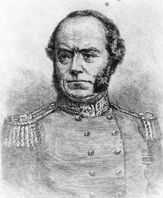 The Maranoa region of Queensland is far from Scotland but it was the fertile woody lands west of Roma that most appealed to the Stirlingshire-born surveyor-general of NSW, Sir Thomas Livingstone Mitchell. Mitchel was a Lieutenant Colonel in the British Army who earned his stripes with the Duke of Wellington in the 1811 Iberian Campaign against Napoleon. Wellington was so impressed by the young Scot, then barely 19, he commissioned him to survey the battlefields. After 16 years of military service the Crown asked him to perform the same duties for the colony of New South Wales as Deputy Surveyor-General.
The Maranoa region of Queensland is far from Scotland but it was the fertile woody lands west of Roma that most appealed to the Stirlingshire-born surveyor-general of NSW, Sir Thomas Livingstone Mitchell. Mitchel was a Lieutenant Colonel in the British Army who earned his stripes with the Duke of Wellington in the 1811 Iberian Campaign against Napoleon. Wellington was so impressed by the young Scot, then barely 19, he commissioned him to survey the battlefields. After 16 years of military service the Crown asked him to perform the same duties for the colony of New South Wales as Deputy Surveyor-General.
Mitchell’s boss was John Oxley who opened up areas of New South Wales including the Lachlan, Macquarie and Tweed Rivers to white settlers. With botanist Allan Cunningham, Oxley beat an inland path to Queensland via the Brisbane River. The rigours of explorations led to Oxley’s death in 1828 aged 45. Suddenly Mitchell was promoted into the role he would keep for four major expeditions over the next 27 years. The first in 1831 took Mitchell north of Sydney towards Tamworth. He found the Gwydir River and turned inland till he found the Darling. After natives killed two helpers, Mitchell returned to Sydney to plan his next sortie. It took four years to return to the Darling but he was determined to find out where this long meandering river emptied into the sea. His botanist Richard Cunningham was killed by Aborigines and Mitchell had to withdraw again after a skirmish.
Undaunted, he was back a year later to try again. There was more battles with natives and he killed seven of a posse of 200 that attacked him. He followed the Darling until it joined the Murray near Wentworth. Mitchell found the Grampians and followed the Glenelg River to the Bass Strait coast near Nelson. Mitchell returned to Sydney a hero after opening up this vast stretch of Australia Felix to Europeans.
Having mapped much of what would become Victoria, he would do the same for what would become Queensland. With fellow explorer Edmund Kennedy he set off north on December 15, 1845. Then aged 54, Mitchell took a familiar route, striking out north-west for the Darling, as he had done three times before. This time he continued north to the Narran River, the Balonne and the Culgoa. Near the junction of the Maranoa and Balonne rivers, Mitchell found a natural bridge on April 23, 1846. He named the bridge for the auspicious saint’s day, St George’s Bridge.
Mitchell followed the Cogoon Creek which he renamed what he thought the natives called it: Muckadilla Creek. This took him into great pastoral country west of what is now Roma. He named a hill in the region Mt Abundance and from its top, marvelled over what he called a “a champaign region, spotted with wood, stretching as far as human vision or even the telescope would reach.” Mitchell continued west to find the Warrego and Barcoo Rivers but it was his description of Mt Abundance that resonated. By champaign Mitchell meant undulating country, but many who followed in his path were made drunk by his vision.
Back in Sydney, he told friend and fellow Scot William Macpherson about his discoveries. His son Allan Macpherson held lands at Keera in New England and Mitchell encouraged him to try his luck at Mount Abundance. Heading north-west and crossing St George’s Bridge in the path of Mitchell, Macpherson was the first white settler of the Maranoa in 1847 just a year after his mentor, bringing his workers, cattle and sheep.
Watched closely by the Mandandanji whose lands he craved, Macpherson was fearless and carried guns to enforce his law. Ultimately he was unsuccessful but he laid open the path for others to follow both from the south and from the east to the Darling Downs. Thanks to Mitchell, Macpherson had changed the region forever.
2 thoughts on “Major Mitchell and the Maranoa”